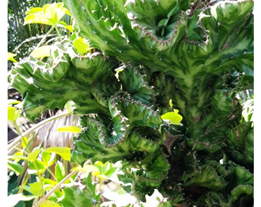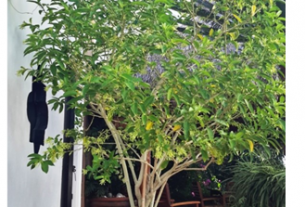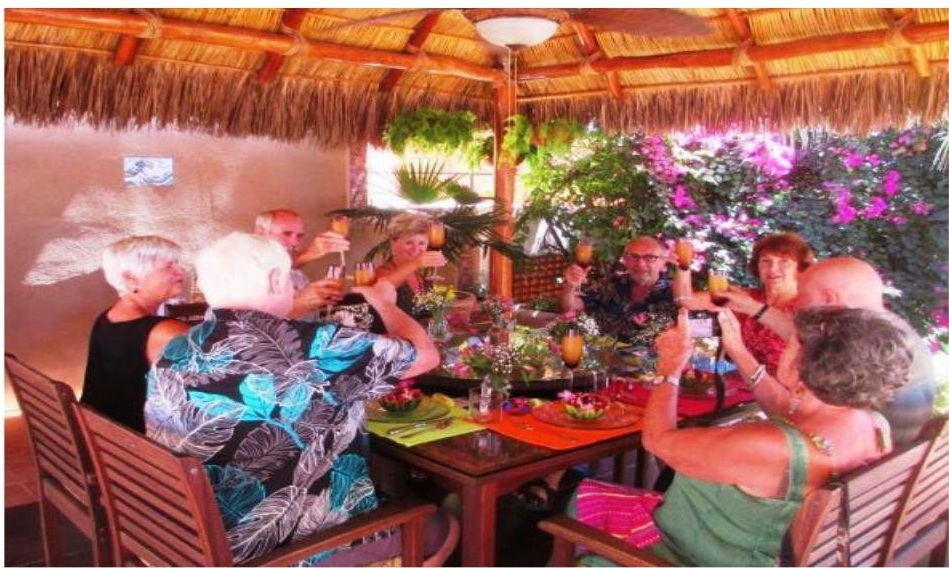By Tommy Clarkson on the December 2020 Edition
Narrow-Leaf Chalksticks Senecio vitalis
Family Ateroceae
Also known as Blue Chalk Fingers or Senecio
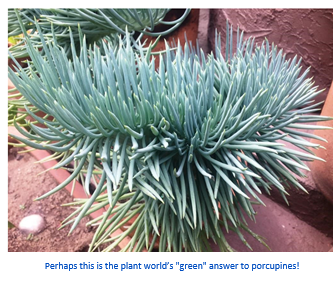 (Right now, I am sorely dismayed, displeased and disgusted with a specific species of the insect world. How, why, what and where so? Well, to be specific, it is one particularly horned and ugly S.O.B. [son of a bug] in the Coleoptera family – the, nearly two and on-half inch (6.35 cm) long Dinapate wrighti! You see, upon returning from a six-week visit back up north in Gringolandia with family and friends, I found that this beetle manifestation of all that is insect evil, the Palm Borer, had successfully killed four of our most precious and prized palms: a Desert Fan Palm (Washingtonia filifera), a Sugar Date Palm (Phoenix sylvestris) and about which I had yet to fully photo-graph and write a piece on, a Betel Nut Palm (Areca catechu) the species being of “Bloody Mary” fame from the musical “South Pacific” and our absolute pride and joy, a huge, male Medjool Date Palm this being the son of a palm that grew next to one of Saddam Hussein’s palaces in Iraq! This quadruple botanical homicide OK, OK, I tend to be a bit dramatic is as if we have lost dear family members to a vicious killer [from the largest order of animals on planet earth] which appears to fly amok through the garden killing randomly!)
(Right now, I am sorely dismayed, displeased and disgusted with a specific species of the insect world. How, why, what and where so? Well, to be specific, it is one particularly horned and ugly S.O.B. [son of a bug] in the Coleoptera family – the, nearly two and on-half inch (6.35 cm) long Dinapate wrighti! You see, upon returning from a six-week visit back up north in Gringolandia with family and friends, I found that this beetle manifestation of all that is insect evil, the Palm Borer, had successfully killed four of our most precious and prized palms: a Desert Fan Palm (Washingtonia filifera), a Sugar Date Palm (Phoenix sylvestris) and about which I had yet to fully photo-graph and write a piece on, a Betel Nut Palm (Areca catechu) the species being of “Bloody Mary” fame from the musical “South Pacific” and our absolute pride and joy, a huge, male Medjool Date Palm this being the son of a palm that grew next to one of Saddam Hussein’s palaces in Iraq! This quadruple botanical homicide OK, OK, I tend to be a bit dramatic is as if we have lost dear family members to a vicious killer [from the largest order of animals on planet earth] which appears to fly amok through the garden killing randomly!)
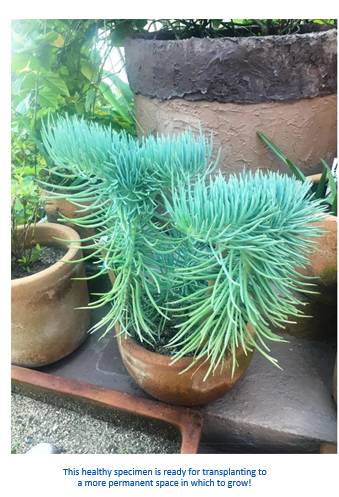 OK, that now out of my system, mark my anger and angst down right there, beside all manner of other emotional turbulence to my getting older, more crotchety and curmudgeonesque. For instance, bringing this all back to the subject, what with my forgetfulness, for the life of me, I am unable to remember where I found this neat and nifty succulent!
OK, that now out of my system, mark my anger and angst down right there, beside all manner of other emotional turbulence to my getting older, more crotchety and curmudgeonesque. For instance, bringing this all back to the subject, what with my forgetfulness, for the life of me, I am unable to remember where I found this neat and nifty succulent!
Rooting around in my tropical plant books, I determined that it is native to the east cape of South Africa . . . but, to the best of my dwindling remembrance, I haven’t been there. No problem, I’ll probably figure it out sooner or later.
In the meantime, I’ll content myself with what the philosopher Friedrich Nietzsche sagely observed, “The advantage of a bad memory is that one enjoys several times the same good things for the first time.”
But, beyond that I was not even sure “what it was!” It took sending a picture to Dr. Mark Olson who was doing research, ironically working in South Africa at the time, to get a lead on it! (Like fellow tropical botanical pals Art Whistler and Anders Lindstrom, he has saved my proverbial bacon no few times!)
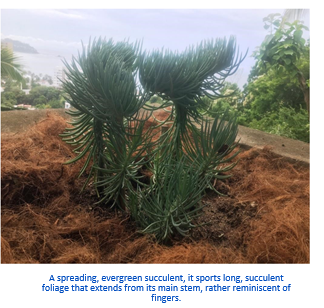 That all said, based on my time attending it and reading what others have experienced/said about it from my library, a picture began to form of this oddly named plant. A spreading, ever-green succulent, it sports long, succulent foliage that extends from its main stem, rather reminiscent of fingers. To my eye, it is most attractive and endearing in appearance. Simply observed, with landscaping objectivity, it provides a unique form and texture to one’s garden. While outdoors it prefers hot, dry conditions, it also makes a superlative specimen for inclusion indoors – indoors, of course, a fully sunny location.
That all said, based on my time attending it and reading what others have experienced/said about it from my library, a picture began to form of this oddly named plant. A spreading, ever-green succulent, it sports long, succulent foliage that extends from its main stem, rather reminiscent of fingers. To my eye, it is most attractive and endearing in appearance. Simply observed, with landscaping objectivity, it provides a unique form and texture to one’s garden. While outdoors it prefers hot, dry conditions, it also makes a superlative specimen for inclusion indoors – indoors, of course, a fully sunny location.
Placed outdoors, it is drought tolerant, liking sandy soil with dry-to-medium moisture, in well-draining soil, while basking in full sun to light shade. In four seasonal climes, it is a bit of an anomaly in that it, purportedly, grows in the winter and is dormant in the summer! That asserted, although succulents are generally thought to be slow growers, and in spite of what my secondary research tells me, mine has grown rather rapidly over this past summer!
—
Tommy Clarkson is a bit of a renaissance man. He’s lived and worked in locales as disparate as the 1.2 square mile island of Kwajalein to war-torn Iraq, from aboard he and Patty’s boat berthed out of Sea Bright, NJ to Thailand, Germany, Hawaii and Viet Nam; He’s taught classes and courses on creative writing and mass communications from the elementary grades to graduate level; He’s spoken to a wide array of meetings, conferences and assemblages on topics as varied as Buddhism, strategic marketing and tropical plants; In the latter category he and Patty’s recently book, “The Civilized Jungle” – written for the lay gardener – has been heralded as “the best tropical plant book in the last ten years”; And, according to Trip Advisor, their spectacular tropical creation – Ola Brisa Gardens – is the “Number One Tour destination in Manzanillo”.

